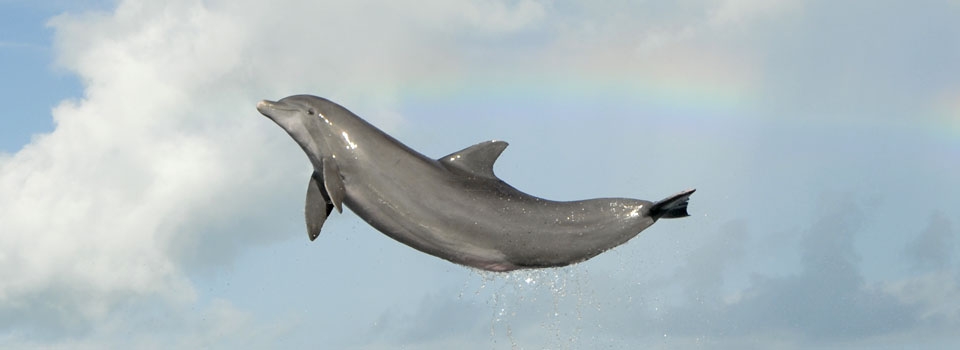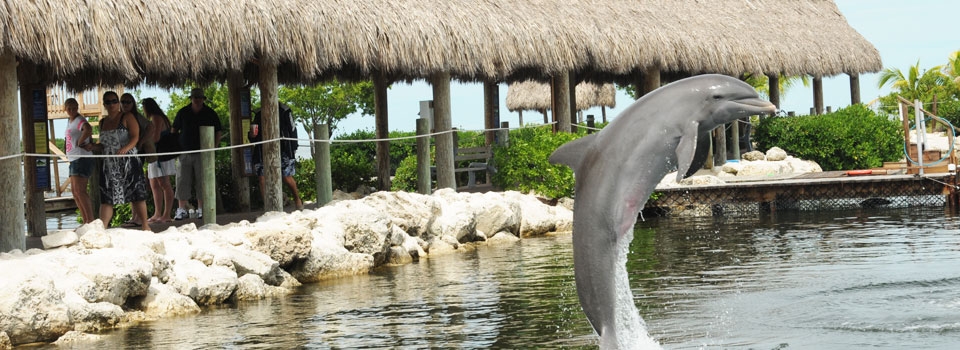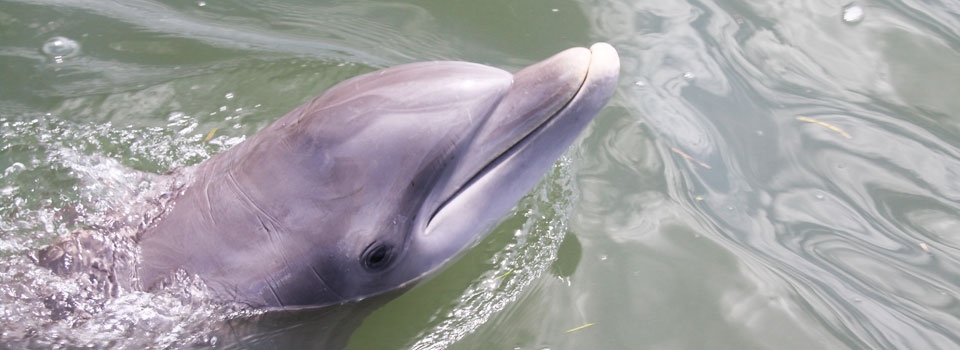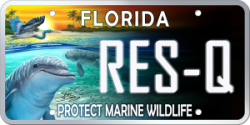- RESEARCH
- LEARN
- Child Education »
- Teen Education »
- Adult Education »
- Resources »
- Kids Zone »
- SHOP

- Providing Sanctuary and a Forever Home since 1984.
- A not-for-profit 501(c)3 marine mammal education and research facility for more than 35 years.
- Providing Sanctuary and a Forever Home since 1984.
A not-for-profit 501(c)3 marine mammal education and research facility for more than 35 years.
Evolution
Evolution
Dolphins are mammals, and have characteristics which are distinct to mammals. They have three middle ear bones, and they have hair at some point during their life cycles, and females have mammary glands which are used to nurse their young. The ocean can be a very harsh place for a mammal to live. However, dolphins are uniquely adapted for the marine environment. How have dolphins and other marine mammals come to live in an aquatic world? Scientists believe evolution holds the key to the answer.
Based on DNA, molecular, and genetic studies, the current theory suggests that cetaceans share a common heritage with that of the hippopotamus. This theory would place cetaceans in the group formerly known as Artiodactyl (now Cetartiodactyla), composed of even toed ungulates (deer, sheep, cows, pigs, hippos, etc.) New skeletal discoveries seem to back this claim, giving possible morphological evidence as testimony. Scientists have recently discovered ancient whale skeletons in Pakistan with well-preserved anklebones displaying features similar to that of the Artiodactyl group. Inside their pectoral fins, dolphins have a skeletal structure similar to a human arm and hand. They have a humerus, complete with a ball and socket joint. They have a radius and ulna, as well as a complete hand structure, including five phalanges, or finger bones. This is one of the many internal physiological structures leading scientists to believe that dolphins and whales evolved from a terrestrial ancestor.
The terrestrial ancestor of the cetacean quickly adapted to a new aquatic niche and the evolutionary process continued at a rapid rate. When animals move into unoccupied niches, evolutionary radiation tends to act swiftly, as it appears to have done in this case. Pakicetus the terrestrial extinct genus that is currently thought to be the direct ancestors to the modern cetaceans.
Ambulocetus is a semi-aquatic to aquatic ancestor to modern day cetaceans which lived approximately 49 million years ago. This evolutionary link displayed subtle changes, resembling a terrestrial animal less and a marine mammal more. The legs on the Ambulocetus were shorter and more paddle-shaped. However, it probably still spent some time on land. The nostrils of this cetacean ancestor had also migrated to the top of the snout, probably to facilitate more efficient breathing. Ambulocetus expended less energy breathing because it only had to poke its nostrils above water as opposed to its whole head.
The oldest and most primitive whales were the Protocetids, a family of archaic whales or Archaeocetes. These whale ancestors arrived around 50 million years ago, during the Eocene Epoch. Due to the locale of their remains, it appears that the earliest phases of cetacean evolution, including the Protocetids, were confined to the Tethys Sea. The jaw of this animal is much more slender and elongated than that of the Ambulocetus. The shape of Protocetus is not entirely clear because most skeletal structures discovered are not complete. It appears that they still had hind limbs, and that their life style may have been amphibious, rather than fully aquatic.
About 38 to 45 million years ago, Basilosaurus, the largest known advanced Archaeocete, appeared. The skeletons of these animals have been found as far south as New Zealand and Antarctica. The spread of this early cetacean would indicate its successful adaptation to aquatic life. Basilosaurus was, in fact, fully aquatic. The forelimbs of Basilosaurus were elongated flippers/paddles. As they elongated, the cartilage between the phalanges fused, preventing the joints from curling. The sinuses in the skull base of the Basilosaurus enlarged, a feature seen also in early toothed and baleen whales. The hind limbs of Basilosaurus became virtually non-existent. At this point, the only function that the hind limbs might have served would have been for alignment in mating, or for pushing off of the bottom of the ocean. While Basilosaurus is one of the best known Archaeocetes, analysis of the skull suggests that Basilosaurus does not have any direct modern relatives.
There were many other evolving forms that led to the modern-day cetacean. Baleen whales and toothed whales diverged from a common ancestor around 35 million years ago. The family Delphinidae made its appearance around 11 million years ago, while the bottlenose dolphin emerged only about 2-5 million years ago. Through evolution, dolphins have made significant adaptations to become the aquatic marvels that you see today.
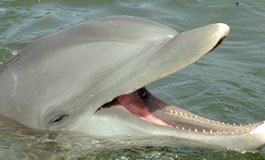
Identification
Identification
Taxonomy
Dolphins and whales belong to the order Cetartiodactyla, which includes all of the even-toed ungulates. Dolphins and whales belong to the infraorder Cetaceans, which contains two suborders: Mysticetes, the baleen whales and Odontocetes, the toothed whales. So, all dolphins are types of whales.
Mysticetes include all of the baleen whales. Baleen whales do not have teeth. Instead they have fibrous plates called baleen which they use as sieves to trap their food. They swallow large mouthfuls of water and plankton, krill, or fish, and push the water out through the baleen plates. The plankton, krill, or fish are too big and become trapped in the fibrous interior of the baleen plates. The whale then uses its tongue to gather and swallow all of the trapped food inside its mouth.
Odontocetes include all of the toothed whales. Toothed whales catch and swallow their prey one by one, grasping them with their teeth. The largest Odontocete is the sperm whale.
The Mysticete sub order only contains four families. The Odontocete suborder has ten families, including the family Delphinidae, to which dolphins belong. It is believed the Odontocete suborder contains many more families than the Mysticete sub order for several reasons. Odontocetes eat a larger variety of foods, and are smaller in size than most Mysticetes, so they are able to fill more niches in their ecosystems.
Dolphins vs. Porpoises
Dolphins and porpoises are both small-toothed whales and are separated into two distinct families. Dolphins belong to the family Delphinidae, while porpoises belong to the family Phoecinidae. There is only one difference that is consistent between a dolphin and a porpoise: the shape of their teeth. All cetaceans in the family Delphinidae have conical shaped teeth. All cetaceans in the family Phoecinidae have flat, spade-shaped teeth.
There are a few other differences that are generally true, but not in every case. Porpoises generally have a blunt, rounded snout, while dolphins have an elongated, protruding rostrum. In general, porpoises are much smaller than dolphins and have a small triangular-shaped dorsal fin, as opposed to dolphins' larger sickle-shaped dorsal fin.
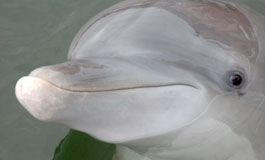
External Physiology
External Physiology
Vision
Dolphins have very good vision both above and below water. Researchers have determined that dolphins are able to see objects as far away as at least 12 to 18 feet in air and around 9 feet underwater (Mass & Supin 1995; Herman et al. 1975; Pepper & Simons 1973). Scientists are still unclear, however, whether or not dolphins have color vision. The number of rods and cones contained in a dolphin’s eye are believed to facilitate a greater range of light intensity rather than color.
When looking at things below the surface of the water, an oily glandular secretion helps protect a dolphin’s eyes from the elements. The corneas and lenses of a dolphin’s eyes are shaped to see light through water. The ocular muscles, however, seem to bend the lenses to accommodate above-water viewing.
A dolphin’s pupil is shaped like a horseshoe when it is fully dialated. In extremely intense light, a dolphin’s pupil constricts down to two tiny openings, in essence a “double pupil” (Herman et al., 1975). Instead of dealing with very intense light focused on one single point of the retina, the double openings allow for two smaller points of lesser intensity to be used instead. The smaller the opening through which light passes, the greater the distance far-away objects remain in focus. Parallel light rays produce a perfect image without the necessity of focusing, therefore, the “double pupil” helps a dolphin have acute vision both in air and underwater during the day. This same structure may also play a part in a dolphin’s depth perception.
Dolphins also have very good night vision with the aid of a beautiful blue/green tissue called the tepetum lucidum. This tissue gathers all available light in a low light situation and reflects it back through the lens allowing for better vision. Cats, dogs and a variety of other animals have a tepetum lucidum allowing for night vision.
Teeth
A dolphin is born with 72 to 104 teeth. This original set of teeth will last a lifetime. The dolphin's smile contains a gap where you might expect to find front teeth. This gap allows the baby to latch on to the mother’s nipple without biting her.
Scientists have found that every year a dolphin lays down a new layer of enamel inside its teeth, causing a ring to form inside the tooth. Therefore, one of the ways we can determine the age of a dolphin is by counting the enamel rings found inside the teeth, one for each year of its life. This is similar to counting the rings inside a tree to determine its age.
Dolphins seem to live an average of 25 years, although some dolphins have lived into their early 60s. As a dolphin gets older, it becomes very difficult to count rings in their teeth since they are so tightly compressed.
Skin
The core of a dolphin’s body is well insulated by a thick layer of blubber. Generally, a blubber layer is anywhere between ¾” to 1¼” thick. The thickness is related to the type of environment the dolphin lives in. Colder waters require a thicker blubber layer. The blubber is actually the modified third layer or “hypodermis” of a dolphin’s skin. Skin is made up of three layers: an epidermis (top layer), a dermis (middle layer) and a hypodermis (bottom layer). The surface layer, or epidermis, of a dolphin’s skin is ten times thicker than any land mammal, and serves as protection against the elements. Additionally, the entire top layer of skin sloughs off every two to four hours, helping the dolphin stay streamlined, moist and free of external attachments while traveling through the water.
A dolphin has very pliant skin. When a dolphin reaches a certain speed while traveling through water, the typical smooth flow of water becomes more turbulent. A dolphin’s skin will actually ripple at accelerated speeds to counter the effect of turbulence as they travel through the water.
Hair
Bald is beautiful, especially on a dolphin. However, being mammals, even dolphins have hair at one point in their life. When they are born, dolphins have whiskers on their rostrum. A dolphin’s whiskers are about one quarter inch long, and will fall out shortly after birth, as a result of water pressure. Even so, the follicular pits remain open. One can see these follicular pits on the rostrum of any dolphin. They probably serve some sort of sensory function, like the detection of speed or current. Some great whales and one type of river dolphin retain whiskers their entire lives.
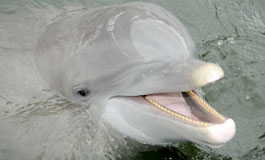
Internal Physiology
Internal Physiology
Skeleton
The skull of the Mysticete is bow-shaped, while the Odontocete skull is compact and has a parabolic dish shape. The Mysticetes' bow-shaped skull is adapted to accommodate its baleen. The skull shape also suggests that Mysticete probably do not possess any echolocation capabilities. The thickness of the Odontocetes' skull is adapted for its unique feeding requirements. The compact, thick skull provides a large base for muscles to anchor, allowing for the power needed to catch prey. The parabolic dish shape of the Odontocete skull is believed to play a large part in the echolocation abilities of the Odontocete.
The spinal cord of the Odontocete is much thicker than that of the Mysticete relative to size. This seems to again be related to feeding practices. Mysticetes do not have to move quickly to catch their prey. They feed on slow moving creatures such as plankton or krill. Mysticetes also have no natural predators to outrun. As they do not need to move quickly, they do not require an extensive muscle mass. Odontocetes, however, have predators they must outrun as well as prey they must chase and catch. Both of these activities require a large muscle mass. Once again, a larger bone surface area would accommodate a more extensive muscle mass.
Blood Pressure
While diving a dolphin’s heart rate drops as low as 12 beats per minute, conserving oxygen while submerging. When resurfacing, a dolphin’s heartbeat can skyrocket to 120 beats per minute. If this fluctuation occurred in a human, he/she would probably have a stroke. A dolphin, however, is able to handle the quick change in blood pressure because of a special adaptation called the retia mirabilia. The retia is a tissue found underneath the ribcage, between the blowhole and dorsal fin area. It consists of a dense mass of blood vessels that act like a sponge. The arteries in a dolphin feed into the retia, rather than going directly to the brain. The diverted blood flow saturates the vessels within the retia, like a sponge, when a dolphin’s heart rate is high. The retia then controls the flow of blood to the brain, maintaining a consistent flow, no matter how much blood is contained in its vessels. Thus, the retia acts as a buffer, protecting against a surge of blood during high blood pressure, and against a lack of blood flow during reduced heart rates.
Reproduction
One of the characteristics of mammals is the ability to bear live young and nurse them for a period of time. Dolphins put a large amount of energy into raising their young, which stay with them an average of three to six years. (More information about the reproductive and maternity cycles of the bottlenose dolphin may be found in the Dolphin Research Center Maternity Information File.)
Respiratory System
Dolphins breathe air directly into their lungs via the blowhole. Dolphins and whales can also use their blowhole to create sounds. Odontocetes have only one nasal opening, or blowhole, at the surface of the skin. They do have two nasal passages underneath the skin, but the septum does not rise all the way to the surface.
Mysticetes have two nasal openings, or blowholes, at the surface of their skin. The septum rises all the way to the surface of a Mysticetes skin. Whalers could actually identify whales from afar by their blow. Odontocetes have a blow that shoots straight up, while Mysticete blows fountain out. In a sperm whale, only the left nasal passage rises to the surface. The right nasal passage circles around inside the head and is speculated to be associated with sound production.
Cetaceans do not breathe through their mouths at all. In fact, the trachea and esophagus are completely separated with the aid of an organ called the goose beak. The goose beak is an evolutionarily modified larynx that bridges the gap between the nasal passages and the trachea, and is designed to keep anything but air out of the lungs. It is a cartilaginous organ that sits unattached, but tightly fit, inside the sporacular channel found in the skull underneath the blowhole.
Sometimes it is necessary to administer fluids and medications to a dolphin via a stomach tube. The elasticity of a dolphin’s throat tissue, combined with the separation of trachea and esophagus make the tubing process quite easy. This process is quite uncomfortable for a human due to the epiglottis and a gag reflex. Humans and other mammals have a gag reflex to protect their lungs from swallowing foreign objects into the trachea from the mouth. Dolphins have no gag reflex, since the trachea and esophagus are completely separated. So, this procedure does not bother a dolphin.
Digestive System
A dolphin has a three chambered stomach, similar to an ungulate (cow or deer), pointing further to its evolution from a terrestrial ancestor. Since dolphins do not chew their food, the mastication of their meal is taken care of in their first or fore stomach. The majority of digestion is processed in the main stomach or second chamber. The last section of their stomach, the pyloric stomach, takes care of the remainder of their digestion prior to the contents emptying into the intestinal region.
Renal System
In making the change from terrestrial to aquatic living, cetaceans needed a way to accommodate for the higher salinity of their environment. Unlike human kidneys, which are just two singular renules (or balls), dolphins have two kidneys with multiple renules. These renules all function as separate kidneys which help filter out the higher amount of salt content they must deal with in their daily environment.
Dolphins also have a very small bladder, which causes them to urinate frequently. Dolphins can be taught to give a urine sample on command for medical purposes.
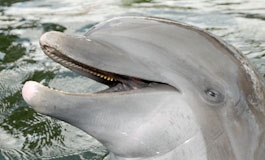
Amazing Abilities
Amazing Abilities
Temperature Regulation
How does a dolphin keep warm in the water without hair? Water conducts heat away from the dolphin's body twenty-five times more efficiently than air. There are two ways that dolphins keep warm: through insulation provided by their blubber and through thermoregulation.
All mammals are warm blooded, which means they can regulate their own internal body temperature. If you look closely, you can see many veins running through the tail flukes of a dolphin. These veins are important for maintaining the internal body temperature of a dolphin.
The tail, dorsal fin, and pectoral fins are great places for a dolphin to release heat because they contain no blubber. Inside the flukes, dorsal fin, and pectoral fins are a bunch of arteries surrounded by a network of veins. Along the surface of the skin, in these areas, are more veins and smaller capillaries. Cetaceans use this unique circulatory arrangement to deal with thermoregulation. The process is called counter-current heat exchange. During the winter, when a dolphin needs to keep warm, arteries leading from the core of the body to the cooler flippers, flukes and dorsal fin, are surrounded by veins leading from these same areas. In this way, blood returning from cooler areas to the body is warmed and heat loss is minimized (cool venous blood traveling next to the hot artery is warmed).
In the summer, a dolphin keeps cool by increasing blood flow out to the extremities. The outgoing arteries expand with the increased blood flow. The veins and capillaries along the surface of the skin also expand, allowing heat to be released through the surface of the skin. Because the veins surrounding arteries cannot conduct such a large flow of blood back into the body, some blood must return along the peripheral veins close to the surface of the skin. The heat from the blood is lost through the surface of the skin and transferred into the environment. Some of the blood returning from these areas is still cold when it enters the core of the body; thus, cooling the animal down.
Motion
While skin and other parts of a dolphin’s body contribute to its graceful movement, the tail flukes provide the power. The tail is the strongest part of the dolphin’s body. All cetaceans move their tails up and down, rather than side to side like a fish. The upstroke is believed to be the more powerful stroke for a dolphin. When a dolphin moves its tail down, the tips of the tail bend upward, creating less surface area to push with. When a dolphin moves its tail up, the tips of the tail remain ridged and flat, creating maximum surface area to propel with. Another clue indicating a more powerful upstroke than downstroke is the muscle movement. When a dolphin moves its tail upward, the large muscle mass along its back must contract, and contracted muscles are stronger.
Diving
The maximum recorded & published depth achieved by an offshore common bottlenose dolphin during a dive exceeded 1614 feet (Klatsky, et al., 2007). Wild coastal bottlenose dolphins spend the majority of their time in water that averages 7-10 feet deep. Offshore animals are believed to frequent much deeper depths. Diving depths are directly related to the needs (food in particular) of a dolphin. Pressure changes and oxygen conservation are of primary concern during diving. Dolphins have special ways of dealing with these issues. They can hold their breath for 7.25 minutes. When a dolphin respires, it replenishes over 70-90% of its lung capacity. Humans only replenish about 17% at a time. When diving, a dolphin slows its heartbeat as low as 12 beats per minute. Blood flow is reduced to a minimum to conserve the energy and oxygen of the animal. Dolphins have a flexible ribcage with a large number of free-floating ribs, which aid on deep dives. At a certain depth, high pressure causes a dolphin’s lungs to collapse. A flexible ribcage facilitates this process.
Where does a dolphin store its oxygen when it dives? The darkness of the muscle indicates a high oxygen concentration. Dolphins store oxygen in their muscles with the help of a blood protein called myoglobin. In fact, dolphins have a higher blood volume than most terrestrial animals. Dolphins can store 41% of oxygen intake within their muscle tissue. Humans can only store 19% of oxygen intake within their muscle tissue. Because oxygen is already stored within the muscle tissue, dolphins can slow down their blood circulation to a minimum.
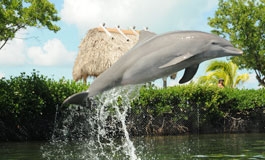
References
References
Through millions of years of evolution, dolphins have made significant adaptations to survive in an environment that is typically very hostile toward mammals. Through time, they have become one of the most well equipped and efficient creatures of the sea. The following references are good sources for further information regarding the incredible physiology of cetaceans.
Berta, A. and J. L. Sumich. 1999. The Evolutionary Biology of Marine Mammals. Academic Press: San Diego, CA.
Bryden, M. M. and R. Harrison, ed. 1986. Research on Dolphins. Oxford University Press: New York, NY.
Herman, L. M., ed. 1980. Cetacean Behavior. John Wiley and Sons, Inc.
Hoelzel, R.A., ed. 2002. Marine Mammal Biology. An Evolutionary Approach. Blackwell Science, Ltd. Malden, MA.
Leatherwood, S. and R. R. Reeves, ed. 1990. The Bottlenose Dolphin. Academic Press: San Diego, CA.
Norris, K. S. 1991. Dolphin Days: The Life and Times of the Spinner Dolphin. Norton: New York, NY.
Pryor, K. and K. S. Norris, ed. 1991. Dolphin Societies: Discoveries and Puzzles. University of California Press: Berkeley and Los Angeles, CA.
Reynolds, III, J. E. and S. A. Rommel. 1999. Biology of Marine Mammals. Smithsonian Institution Press: Washington and London.
Reynolds III, J.E., R.S. Wells, and S.D. Eide. 2000. The Bottlenose Dolphin: Biology and Conservation. University Press of Florida: Gainesville, FL.
Ridgeway, S. H. and R. Harrison, ed. 1994. Handbook of Marine Mammals, Volume 5: The First Book of Dolphins. Academic Press: San Diego, CA.
Ridgeway, S. H. and R. Harrison, ed. 1999. Handbook of Marine Mammals, Volume 6: The Second Book of Dolphins and the Porpoises. Academic Press: San Diego, CA.
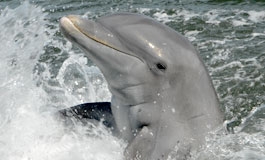
Our Mission -
Through education, research and rescue, Dolphin Research Center promotes peaceful coexistence,
cooperation and communication between marine mammals, humans and the environment we share with
the well being of DRC's animals taking precedence.
